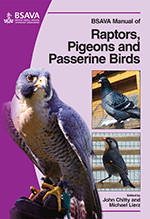
Full text loading...

Anatomy of the avian eye is well covered by Martin (1985) , to which the reader is directed for further information. The avian eyelids are mobile, the lower more so than the upper. This chapter examines anatomy and physiology; clinical examination; ocular disease: diagnosis and treatment; and enucleation.
Raptors: ophthalmology, Page 1 of 1
< Previous page | Next page > /docserver/preview/fulltext/10.22233/9781910443101/9781910443101.25-1.gif

Full text loading...













